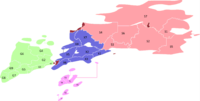Difference between revisions of "Archive:Haiseary"
m (Ava moved page Haiseary to Archive:Haiseary) |
Total pleb (talk | contribs) m |
||
| Line 1: | Line 1: | ||
{{OOD}} | |||
{{Infobox country | {{Infobox country | ||
|conventional_long_name = Grand Duchy of Haiseary <!--Formal or official full name of the country in English--> | |conventional_long_name = Grand Duchy of Haiseary <!--Formal or official full name of the country in English--> | ||
Latest revision as of 20:11, 13 January 2021
 | This article or section is out of date. A country/countries relevant to this article have been removed from Sahar and have been retconned. Not everything here may still be considered canonical. This page was last edited by Total pleb (talk | contribs) 3 years ago. (Update) |
| Grand Duchy of Haiseary "haiđkjérrelineanjulemihkeáma" |
||
|---|---|---|
| Anthem: ""Prinnearka?"" Royal anthem: ""Toachímiei"" |
||
| Capital and Metropolitan conglomeration | Iſtinkír | |
| Official languages | Haisearelic | |
| Recognised regional languages | Taisearelian | |
| Demonym | Haisearelian | |
| Government | Constitutional unitary diarchy | |
| - | Co-Grand Duchess | Meukjær II |
| - | Co-Grand Duchess | Etinkír XVIII |
| - | Tetraministress | Caieariel Zepprſizínn |
| - | Tetraministress | Filúmil Nenta Jr. |
| - | Tetraministress | Lohteár Veitfrér |
| - | Tetraministress | Hameágja Killáhta |
| Legislature | Ikténiéa | |
| - | Upper house | Eimna |
| - | Lower house | Áhknei |
| Independent | ||
| Area | ||
| - | 1,081,134 km2 417,428 sq mi |
|
| - | Water (%) | 5,48% |
| Population | ||
| - | 2017 estimate | 12161290 |
| - | 2016 census | 12162757 |
| - | Density | 11.25/km2 29.1/sq mi |
| GDP (nominal) | 2017 estimate | |
| - | Total | 381935520 |
| - | Per capita | 31402 |
| Gini | 0.438 low |
|
| HDI (2016) | 0.843 very high |
|
| Currency | Haisearelian Meicai (HMM) | |
| Time zone | (SCT+8, +9) | |
| - | Summer (DST) | Not observed (SCT) |
| Date format | yyyy-ddd | |
| Drives on the | right | |
| Calling code | 42 | |
| Internet TLD | na | |
Haiseary (Haisearelic: neanhaiđkjérreli [nɛnˈhɑí.çea.r̥el.i], Taisearelian: Tázérel nen [ta:ˈze:.rel nen]), officially the Grand Duchy of Haiseary, is a country located in the Mirarian Far East, bordering Achiyitqana to the north and Yrakksi to the west. It measures 1081134 square kilometres, and has primarily a subarctic climate. Its current political system, a constitutional diarchy arose in 1896, and is considered one of the countries with the worst gender discrimination in the world, and the only county to have a female-only legislature. It has in the 20th and 21st centuries been represented in the world stage by the female line of the Ehtinkírimié dynasty. The sole official language is Haisearelic, spoken by 86% of the population. Taisearelian, the second-largest language in Haiseary, spoken by 10%, is considered a non-intelligible dialect of Haisearelic in Haiseary. The Haisearelian fish products are often considered one of the best in Eastern Miraria.
Etymology
History
Geography
Geology
Climate
Biodiversity
Politics
Government
Administrative divisions
Haiseary is divided into 3 regions, 22 districts, 6 autonomous districts and 5 ducal administration zones. Each region is named after their relative position in Old Thargian, sulx, xịḍ and gèrsäń for east, centre and west, respectively. Taiseary is not part of any region, and instead a group of six autonomous districts sharing greater freedoms, like having their own flag and common legislature. Haiseary's districts are named after their region's initial, and a number in ascending order from east to west. Newer districts, split from other districts (or annexed, in the case of G8) are numbered chronologically, and do not follow the east-to-west naming order. The regions are by definition not administrative divisions, mere geographical groupings of the districts which do not have a regional government nor any authority. Haiseary's districts provide law enforcement, infrastructure and but otherwise do not have notable autonomy. Five areas, namely the capital Iſtinkír, the island of Míhna, the border to Achiyitqana, an unnamed area in district S7 and the city of mohtitlié are directly administered by the diarchy, but are not marked as such on Haisearelian maps, instead appearing as its own district in the case of Iſtinkír, split between the bordering districts in the case of the Achiyitqan border, or wholly part of districts X1, X4 and S7 in the case of the others.
